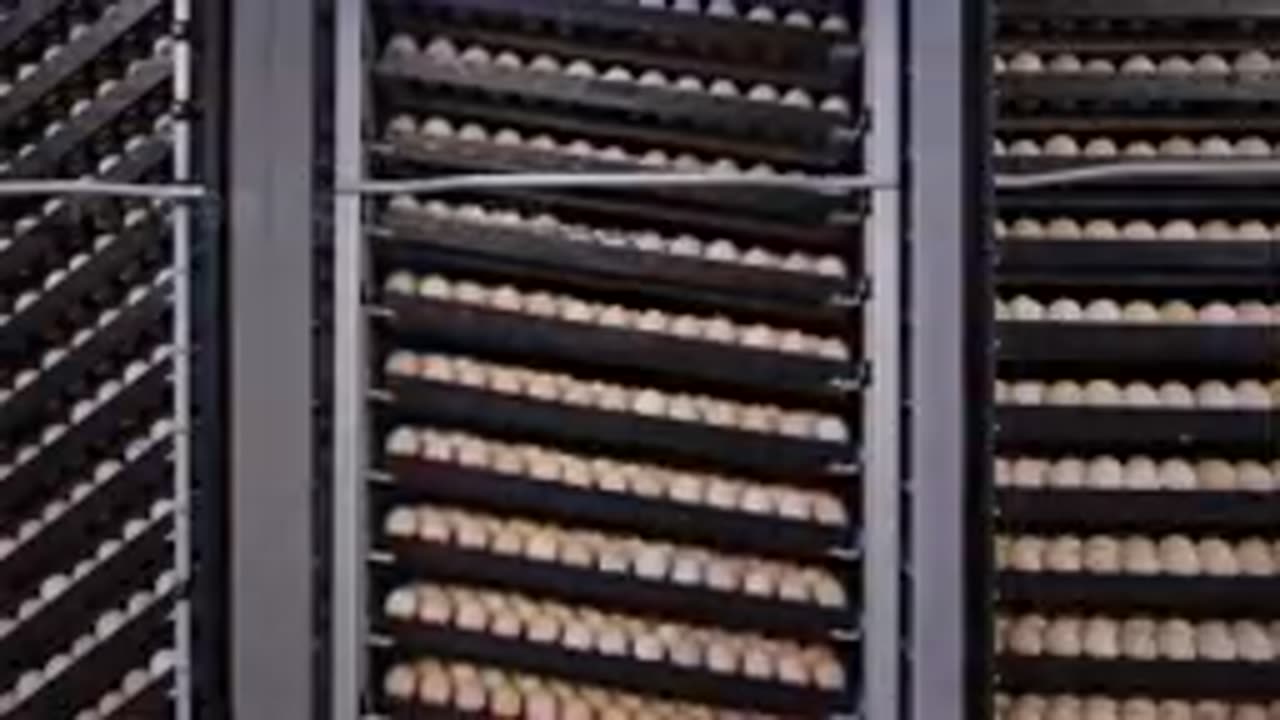Premium Only Content

How Americans Produce 97,3 Billion Eggs Every Year - Chicken Farming Documentary
Producing 97.3 billion eggs annually in the United States is a massive industrial feat, driven by modern technology, precision farming practices, and strict food safety standards. Here’s a step-by-step overview of how it’s done:
---
### **1. Breeding and Hatcheries**
- **Egg-Laying Breeds**: Specialized breeds like White Leghorn chickens are raised for their high egg production rates.
- **Hatcheries**: Fertilized eggs are incubated in large-scale hatcheries. Once hatched, chicks are vaccinated and sorted by sex, with females destined for egg production.
---
### **2. Raising Pullets**
- **Growth Phase**: Young hens (pullets) are raised in controlled environments for 16-18 weeks before they begin laying eggs.
- **Balanced Diet**: Pullets are fed high-nutrient diets to prepare their bodies for egg production.
- **Lighting Control**: Artificial lighting systems simulate daylight, optimizing their reproductive cycles.
---
### **3. Layer Hen Housing Systems**
- **Caged Systems**: Hens are kept in battery cages for efficient space use and easier egg collection.
- **Cage-Free Systems**: Hens roam in open barns with nesting areas, reflecting consumer demand for more ethical practices.
- **Free-Range Systems**: Some hens have outdoor access, typically for organic or specialty eggs.
---
### **4. Feeding and Watering**
- **Automated Systems**: Conveyor belts and automated feeders deliver precise amounts of feed and clean water.
- **Nutrient-Rich Diet**: Feed is fortified with calcium, protein, and vitamins to enhance egg quality and shell strength.
---
### **5. Egg Laying and Collection**
- **Peak Production**: Hens lay an average of 250-300 eggs per year, peaking at around 30 weeks old.
- **Automated Egg Collection**: Conveyor belts collect eggs as they are laid, minimizing handling and contamination.
---
### **6. Cleaning and Sorting**
- **Washing**: Eggs are cleaned with warm water and mild detergents to remove dirt and bacteria.
- **Candling**: Eggs are passed over bright lights to inspect for cracks or defects.
- **Sorting**: Eggs are graded by size (small, medium, large, jumbo) and quality (Grade AA, A, or B).
---
### **7. Packaging**
- **Automated Packing**: Machines place eggs in cartons labeled with nutritional information, expiration dates, and origin details.
- **Specialty Packaging**: Organic, cage-free, or omega-3 enriched eggs are packaged separately for specific markets.
---
### **8. Distribution**
- **Cold Chain Logistics**: Eggs are transported in refrigerated trucks to maintain freshness.
- **Retail and Food Service**: Eggs are delivered to supermarkets, restaurants, and food manufacturers.
---
### **9. Waste and Sustainability Practices**
- **Hen Waste**: Manure is processed into fertilizer or biofuel, reducing environmental impact.
- **Byproducts**: Non-viable eggs and shells are repurposed for animal feed or other industries.
---
### **10. Economic and Global Impact**
- **Scale**: The U.S. egg industry employs thousands and contributes significantly to the economy.
- **Exports**: A portion of eggs and egg products are exported worldwide.
---
### **Challenges**
- Balancing productivity with animal welfare.
- Adapting to consumer demands for cage-free and organic products.
- Ensuring biosecurity to prevent disease outbreaks like avian flu.
Would you like to explore any specific part of this process, such as technology, hen welfare, or sustainability efforts?
-
 1:14:02
1:14:02
Donald Trump Jr.
9 hours agoThe USAID Truman Show, Interview with Mike Benz | Triggered Ep.214
131K178 -
 1:37:34
1:37:34
Precision Rifle Network
1 day agoS4E4 Guns & Grub - You Can't Handle The Truth!
11.6K -
 56:14
56:14
Flyover Conservatives
22 hours agoSick, Tired, & Foggy? The TRUTH About What’s Living in Your Gut! - Dr. Jason Dean | FOC Show
30.1K1 -
 34:24
34:24
Kimberly Guilfoyle
9 hours agoFaith, Fairness, and a Better Future: Live w/ Joy Pullmann & Elizabeth Mitchell | Ep.194
135K30 -
 1:12:20
1:12:20
Josh Pate's College Football Show
7 hours ago $2.81 earnedBig CFB Changes Coming | DeBoer Fixing Alabama | Signing Day Reaction | OhioSt vs Michigan Shift
47.8K2 -
 59:39
59:39
The StoneZONE with Roger Stone
4 hours agoEXCLUSIVE: James O'Keefe Talks to Roger Stone About Dropped Charges Against Him | The StoneZONE
37.9K2 -
 1:48:10
1:48:10
megimu32
4 hours agoON THE SUBJECT: Comedian LOSES It At Heckler!
23.7K3 -
 1:17:13
1:17:13
Redacted News
8 hours agoTRUMP IS BURNING IT ALL DOWN AND DEMOCRATS WANT HIM IMPEACHED AGAIN, USAID ROT GOES DEEP | Redacted
172K359 -
 52:23
52:23
Candace Show Podcast
8 hours agoUPDATE! Taylor Swift Goes Full Dragon Against Blake Lively | Candace Ep 144
148K218 -
 LIVE
LIVE
VOPUSARADIO
1 day agoPOLITI-SHOCK! KILL THE DEEP STATE!! PLUS: 3 SPECIAL GUESTS!
140 watching